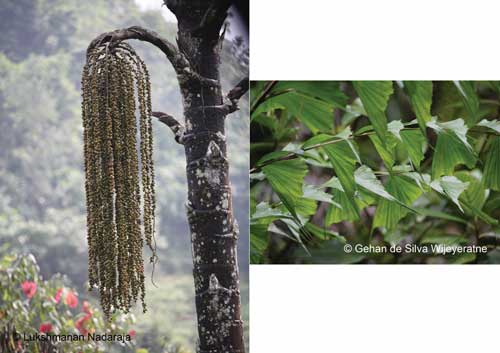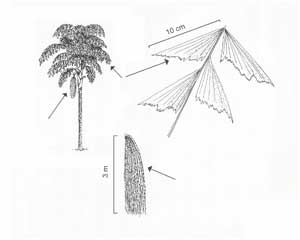Versatility is its name
View(s):
Can be identified readily by its horse tail-like bunch of drooping flowers (pic by Lakshmanan Nadaraja) and triangular leaflets that look like fish fins or tails (pic by Gehan de Silva Wijeyeratne
Caryota urens
Common/ English name: Fish tail palm
Family: Arecaceae (The palm family)
Sinhala name: Kitul;
Tamil: Tippillipanai
These medium-sized trees are native to India, Sri Lanka and Malaysia. They are found in the low country, as sub-canopy trees in lowland rainforests. They are also grown scattered in urban areas such as Colombo, as well as in home gardens. They have unbranched trunks with cylindrical, ringed, grey barks.
The very elongated, tassels of flowers in bunches are unmistakable as they look like horses’ tails. There are separate male and female flowers on the same bunch.
The very large leaves are deeply curved and drooping, with thick leaf bases that encompass the trunk and overlap each other. These large leaves are divided into smaller leaflets, which are roughly triangular and grooved along the veins. These leaflets resemble fish fins or tails, hence the common name of the tree.
 This tree is valued for its many uses. The stem of young flower bunches is incised and the sap is collected in a pot. This process is called ‘kitul tapping’. The fermented sap yields an alcoholic drink called toddy which, if left longer, turns into vinegar. The unfermented sap is concentrated by boiling to make a thick treacle called ‘kitul pani’. Further concentration yields an unrefined sugar called ‘kitul jaggery’. There is a ready national market for both kitul pani and kitul jaggery.
This tree is valued for its many uses. The stem of young flower bunches is incised and the sap is collected in a pot. This process is called ‘kitul tapping’. The fermented sap yields an alcoholic drink called toddy which, if left longer, turns into vinegar. The unfermented sap is concentrated by boiling to make a thick treacle called ‘kitul pani’. Further concentration yields an unrefined sugar called ‘kitul jaggery’. There is a ready national market for both kitul pani and kitul jaggery.
Pith from the centre of mature trees provides an edible and nutritious starch. The wood is used for various household items and the leaf base is used commercially to make fibre.  Medicinally, the roots and pith are used as remedies for various illnesses. The pith used to be a favourite food of elephants, who, unfortunately, are now largely confined to the dry zone. Leaflets are used as cut foliage in flower arrangements.
Medicinally, the roots and pith are used as remedies for various illnesses. The pith used to be a favourite food of elephants, who, unfortunately, are now largely confined to the dry zone. Leaflets are used as cut foliage in flower arrangements.
Experts say that repeated tapping results in a decrease in fruits and a consequent reduction in the growth of new trees. Formerly, kitul tapping permits were required for tapping in forest reserves, but since 2023, these permits are no longer required and tapping within forest reserves is now permitted.
Extracted from ‘What tree is that? The Ruk Rakaganno Layperson’s Guide to Some Trees of Sri Lanka’. Updated by the author using ‘Flowering plants commonly encountered in Sri Lankan habitats’ (2011) by Sriyanie Miththapala, Siril Wijesundara and Janaki Galappatti. National Trust: Colombo.
Searching for an ideal partner? Find your soul mate on Hitad.lk, Sri Lanka's favourite marriage proposals page. With Hitad.lk matrimonial advertisements you have access to thousands of ads from potential suitors who are looking for someone just like you.


